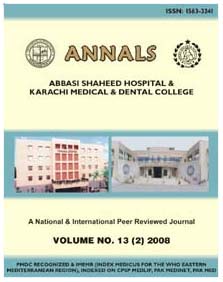
| |
| Home |
| Editorial Staff |
| Instruction to Authors |
| Journal-Issues |
| Policy |
| Copyright |
| A COMPARISON OF COLD LATERAL CONDENSATION AND THERMOPLASTICIZED INJECTABLE GUTTA-PERCHA OBTURATION TECHNIQUES: AN IN VITRO STUDY
1FAYEZ H NIAZI, 2FAHIM A VOHRA, 3MUDASSIR HUSSAIN, 4MOWAFFAQ AL ABSI, 5RAFIQUE A MEMON ABSTRACT Objective: To compare
presence or absence of voids in two different types of obturation
procedures (Cold lateral condensation and Obtura II system) in extracted
teeth using a dental operatory microscope.
|
For
Full text contact to:
|
1Department of Oral Anatomy,
Ziauddin College of Dentistry, Ziauddin University, Karachi.
|

Copyright © 2009 Abbbas Shaheed Hospital and Karachi Medical & Dental College.
All rights reserved.
Designed & Developed by: Creative Designers